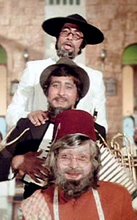There is another tradition of travel and travel writing in Islam, that of safr. Safr is the word for travel or journey in Urdu, and can be used to describe the same in other North Indian languages. To the 11th century Sufi philosopher Al-Ghazali, safr meant travelling through which a person evolves. To him, safr meant as well as the physical act of travelling somewhere, mixing with the inhabitants of that land, imbibing oneself with their customs and ways, and evolving into a person closer to God. If this stuff sounds mystical, it’s meant to — the guy was a Sufi Baba after all! I am not really into this mystical shystical business. I haven’t read Al-Ghazali. I am relying on Chapter 5 of Ziauddin Sardar’s book. There Sardar lists Al-Ghazali’s categories of travellers: those who travel seeking knowledge, the best kind; the Hajis; immigrants — the Prophet himself was an immigrant; and refugees, the worst kind.
Sardar wonders where the line is between immigrants and refugees. We too wonder about that. Rushdie and Naipaul have both written about the uprooting involved in migration. Both have noted that at some level or other, all migrants are really refugees. But for Naipaul, the uprooting is mostly a bad thing. Rushdie is open to the possibility of migration leading to something new. Migrants are works of translation, he writes. Most of us have read Khayyam and Marquez in translation, so translation can’t always be bad.
Brothers A-A-A are also translated men. We may consider Delhi or Karachi or Dhaka as home, but we don’t live in those cities. Nor do we live in Mumbai, Lahore or Kolkata, or anywhere in Desh. And our sojourn abroad is not fixed either. We move from hemisphere to hemisphere, we meet up in different continents, and we record our experiences in these pages.
Well some of us do more than others. Amar is perhaps the most peripatetic, and what are these pictographic exploits but the foundations of a great rihla? Akbar too travels, and his Sufisticated mind will produce some great work of safr in future. I had been the weak-link in our travel credence department. To rectify this, I embarked on a big trip few months ago. Some highlights will be posted in the coming months. As commercial airliners were the mode of transportation for most of the inter-continental trips, I thought I’d begin with this homage to that august industry by the Smithsonian National Air and Space Museum.

